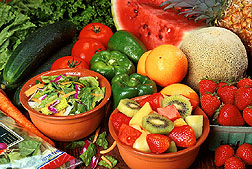This page has been archived and is being provided for reference purposes only. The page is no longer being updated, and therefore, links on the page may be invalid.
|
|
Plant Foods for Preserving Muscle Mass
By Rosalie Marion BlissMay 23, 2008
Fruits and vegetables contain essential vitamins, minerals and fiber that are key to good health. Now, a newly released study by Agricultural Research Service (ARS)-funded scientists suggests plant foods also may help preserve muscle mass in older men and women.
The study was led by physician and nutrition specialist Bess Dawson-Hughes at the Jean Mayer USDA Human Nutrition Research Center on Aging at Tufts University in Boston, Mass.
The typical American diet is rich in protein, cereal grains and other acid-producing foods. In general, such diets generate tiny amounts of acid each day. With aging, a mild but slowly increasing metabolic "acidosis" develops, according to the researchers.
Acidosis appears to trigger a muscle-wasting response. So the researchers looked at links between measures of lean body mass and diets relatively high in potassium-rich, alkaline-residue producing fruits and vegetables. Such diets could help neutralize acidosis. Foods can be considered alkaline or acidic based on the residues they produce in the body, rather than whether they are alkaline or acidic themselves. For example, acidic grapefruits are metabolized to alkaline residues.
The researchers conducted a cross-sectional analysis on a subset of nearly 400 male and female volunteers aged 65 or older who had completed a three-year osteoporosis intervention trial. The volunteers' physical activity, height and weight, and percentage of lean body mass were measured at the start of the study and at three years. Their urinary potassium was measured at the start of the study, and their dietary data was collected at 18 months.
Based on regression models, volunteers whose diets were rich in potassium could expect to have 3.6 more pounds of lean tissue mass than volunteers with half the higher potassium intake. That almost offsets the 4.4 pounds of lean tissue that is typically lost in a decade in healthy men and women aged 65 and above, according to authors. The study was published in the March issue of the American Journal of Clinical Nutrition.
Sarcopenia, or loss of muscle mass, can lead to falls due to weakened leg muscles. The authors encourage future studies that look into the effects of increasing overall intake of foods that metabolize to alkaline residues on muscle mass and functionality.
ARS is the U.S. Department of Agriculture's chief scientific research agency.

